My post-match take on Dominic Thiem’s impressive win over Fabio Fognini on Thursday at the Mutua Madrid Open is now available on Tennis with Accent.
Click to read ====> Thiem Stifles Fognini
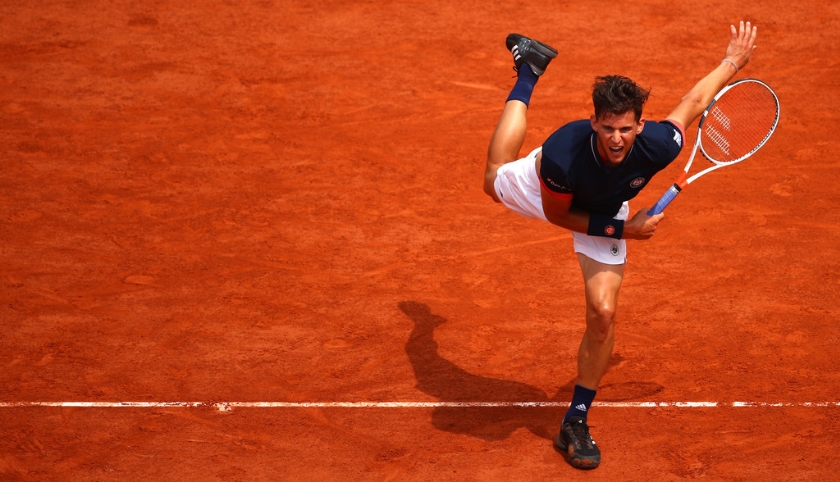
My post-match take on Dominic Thiem’s impressive win over Fabio Fognini on Thursday at the Mutua Madrid Open is now available on Tennis with Accent.
Click to read ====> Thiem Stifles Fognini

Following a slew of upsets and thrillers throughout the first three rounds, the second week features a good mix of opportunistic and in-form players from the middle echelons (as in, not seeded high), and established players eager to confirm their top-player status. Here is my take on three matches, scheduled for Monday, that feature such players.
Caroline Garcia (8) vs Madison Keys (17)
Garcia is having a solid run, a very solid one. I can’t put it on the same level as the quarterfinal-run she had in last year’s Roland Garros – not yet – but it has the potential to match and surpass it. In terms of performing at the Majors, Caro is steadily fulfilling the primary requirement, which is, a string of second-week appearances, gradually pushing the envelope further. You judge for yourself: a third-round run in the 2016 US Open, followed by a quarterfinal and a fourth-round appearances in Roland Garros and Wimbledon in the summer of 2017. This is what I call a healthy progress for a (near-)future contender.
She enters yet another second week in a Major and her road to get there has not been a cakewalk by any means. She had to solve two puzzles in a row in the previous rounds, overcoming the up-and-comer Marketa Vondrousova in the second round, and Aliaksandra Sasnovich next. She passed both tests with flying colors, don’t let the close scorelines tell you otherwise. Garcia offered her best in the final sets of both matches, clutch responses to the successful challenges thrown at her in the earlier portions of each match. Furthermore, Vondrousova and Sasnovich are different players, the former one being a crafty left-hander, and the latter, a solid baseliner with a terrific backhand. Her conquest of both opponents in the extended moments of the final sets shows Caro’s ability to make use of her I.Q. (of which she has plenty, her problem in the past has been nerves, never her on-court astuteness) in dealing with a variety of tasks presented to her.
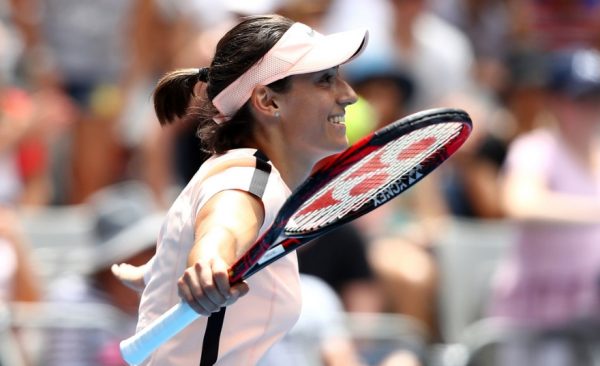 Photo: Cameron Spencer – Getty
Photo: Cameron Spencer – Getty
Keys, last year’s US Open finalist, now presents a daunting challenge to Garcia, not only because she is motivated herself to add another deep run to her list of accomplishments, but also because she can match Garcia’s power and turn the tables on the French’s preferred game plan. It is no mystery that both players would like to dictate rallies, keep their opponents on the run, and eventually finish the point with a baseline or a volley winner. It is also well-known that they struggle if they are forced to play defense, and thus, find themselves in the unusual role of having to scramble from corner to corner. It is that second factor on which rests the key to the outcome of this match.
First question: can each player, if forced to, retrieve a number of successive balls without erring? Second one: if so, can they turn such rallies to their advantage with a counter-punch shot, gain the initiative, and press back successfully? The way each player grapples with the two questions above will determine the winner. I should rather say, the player with the more emphatic “yes” answer to both will reach the quarterfinal round. I believe Garcia is a step ahead of Keys on the first part because she is slightly quicker than Madison with her first step. As to the second question, I am leaning toward the Amrican, only because one of her specialties is nail winners from anywhere on the court, even on the full run. At the end, my nod goes ever so slightly toward Garcia solely based on the fact that her previous two rounds got her primed and ready for Keys, whereas the American has not yet faced an opponent of Garcia’s caliber.
Novak Djokovic (14) vs Hyeon Chung
Couple of the biggest questions coming into the men’s draw have, for the most part, been answered. Djokovic is physically fine and the level of his tennis is not too shabby either. Notice how I threw “for the most part” in the first sentence. We cannot be one hundred percent sure of Novak’s health until the end of this tournament, even if his win against Monfils was played under brutal conditions. He did also get a massage on his back during his last match, though I did not consider that worrisome. I will only feel at complete ease, once he survives a match that goes to distance and comes out to play the next one with still no physical pain. For example, finishing this tournament with zero pain in his arm or any other part of his body would undoubtedly mean that Novak can get back to his regular tournament schedule in 2018. That is my primary wish for him. I missed the Federer-Nadal rivalry prior to last year and was happy to see it make a come back in 2017. I missed Novak last year, and I would equally be happy to see him back in the mix.
The going-to-distance test, that I mentioned above, may very well take place against Chung. The South Korean is consistent, athletic, pesky. He probably feels to his opponents like that chewing gum that gets stuck in your hair and no matter how hard you try, you cannot get it out. He rarely donates points, uses angles efficiently, and accelerates well. Furthermore, he comes into this match with his confidence riding high. The problem for him, lies as much in the details of this particular match-up as the identity of his adversary.
Yes, Novak’s status will play an important role as both players walk on the court. Fans can ignore it or pretend for one day that such notion does not exist, but it will loom large in Chung’s mind. For a young player like him, facing a legend in a Major, is a one of the necessary steps in his own potential transformation into a top player in the future. Usually, the first time it happens, it does not end well for newcomers – remember Roddick’s learning experience in his night-time Arthur Ashe stadium encounter vs Pete Sampras at the 2002 US Open before he became no.1 player one year later?
Regarding the match-up, Chung’s two best shots from the baseline, the inside-out forehand and the cross-court backhand accelerations, play into Djokovic’s strengths. In fact, if there were one area in which Novak does not appear to have lost an iota of confidence, it is his phenomenal ability to absorb heavy balls drilled to his backhand side and send them back with interest, especially down-the-line. I like Chung a lot, but I am afraid his run in this Major stops here. Do not expect his long-term development to halt anytime soon though. This tournament, coupled with his title in the Next Gen ATP Finals in November, are nothing less than confirmations of his steady rise in the ATP ranks.
Fabio Fognini (25) vs Tomas Berdych (19)
How well did Berdych perform against Juan Martin Del Potro in the third round? Extremely well. He may have played his best match ever in a Major, outside of his wins against Roger, Novak, and Rafa in previous ones. It was an eye-opening performance because it came somewhat unexpectedly. Berdych had not impressed anyone with his form since having reached the semis at Wimbledon. He had recorded 4 wins and 5 losses and gotten past the second round only once, in the ATP 250 event in Los Cabos. He has, however, played nothing but solid tennis in Melbourne so far – okay, maybe not in the second set of his second-round match, but let’s not get picky.
His opponent Fognini has had an easier draw – relatively speaking of course – and has at times struggled with his concentration (nothing new there). But he is an underrated performer on the big stage. Frankly, I don’t know how long it will take before the tennis world recognizes how impressive the Italian has been in Majors. I can understand why his on-court antics preoccupy and fascinate most people. However, if you take the time to follow his antics, get amused by them, comment on them, or criticize them, and yet you are half aware of the fact that he has reached the second week of Majors four times, the third round on three different occasions on his least favorite surface at Wimbledon, and been a steady fixture in the ATP top 50 during the last nine years, with substantial time in the top 30, I would argue that you are as much an antic (if not more) as a tennis fan as Fabio is as a player. He is a spectacular shot-maker and I guarantee you that his name is somewhere on top of the list of players that favorites at Majors would like to see the least in their early-round section of the draw.
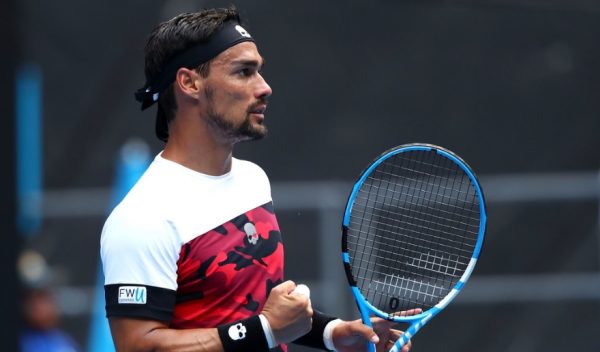 Photo: Cameron Spencer – Getty
Photo: Cameron Spencer – Getty
Fabio has a chance to win if he can derail Tomas’s steady and crisp production of power from the baseline. He is certainly skilled enough to do just that. Thanks to his impeccable timing on his swings, he possesses the ability to create angles and depth regardless of his positioning on the court. I am guessing that Berdych will see some balls come back with a vengeance from Fognini, in situations where other players would be happy to just remain in the point (one example: Fabio’s shot production in his US Open win vs Nadal in 2015). You may think that Berdych already faced that problem with the Del Potro forehand and handled it fine, but Fognini is a different case. Firstly, the Italian can do it from both sides. Secondly, because of his wrist control during the swing, the direction of his shot is hard to read from both wings. He can prepare a certain way to hit a down-the-line flat winner, yet prepare i the same way to fabricate a mid-pace, topspin-angle shot.
If Fognini focuses on the task at hand, and not on the side shows, I am picking the upset here. I know, you don’t have to remind me that I am perhaps expecting a lot. If you insist on doing so though, I would also ask in return, is it not expecting a lot to assume that Berdych will perform at the same level as he did against Del Potro?
Enjoy!
Here is a brief summary of Monday, and I mean “brief” because the rain delay forced a late finish, with the last match between Irina-Camelia Begu and Alize Cornet just finishing moments ago, little before 1 AM. The talented Romanian took out Cornet in straight sets, 6-4 6-4.
While there were a couple of close matches, in general, Monday’s action was lackluster, with only a few matches that went to distance or provided high-quality tennis. It almost seemed like the spectators on the ground were more interested in what was happening outside the matches. Let me travel into the terrain of exaggeration and claim that more people watched Roger Federer, Rafael Nadal, and Nick Kyrgios practice than the tournament matches (first two for obvious reasons, the third for the infamous comment directed at Wawrinka during their match last week). See below the crowds at the Nadal and Federer practices, and keep in mind that people on top are watching them practice rather than the matches on the Grandstand. During Nadal’s practice (on top), Gilles Simon and Ivo Karlovic were playing, and during Federer’s (bottom), Wimbledon finalist Garbine Muguruza was busy getting upset by Yaroslava Shvedova.
And here is a panoramic clip view of the crowd for Federer’s practice.
That was not all. There was a man who had everything planned to propose to his companion (named Michele according to the large banner he had made that said: “Michele, will you marry me?”) during Federer’s practice! She did say “Yes,” and he insisted that Roger hears about it!
Federer finished his practice. Fabio Fognini arrived on the court (with a clean cut and shave) and began his preparation for his encounter vs. Thanasi Kokkinakis later.
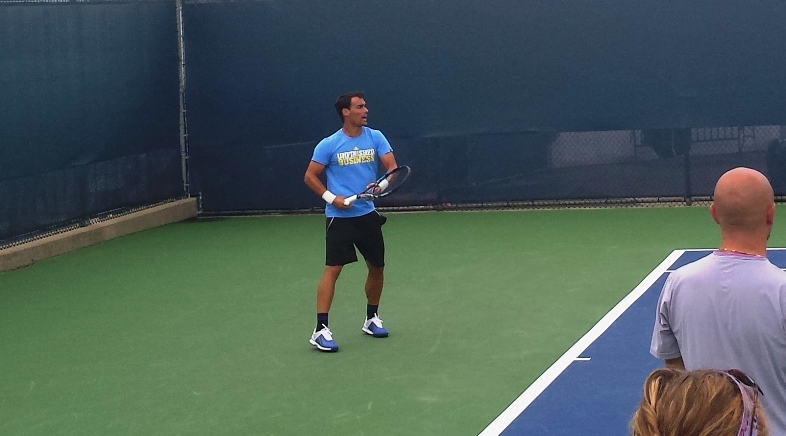
Fognini practiced for about 5 minutes in front a full crowd, because Federer was still on the court chatting with a youngster and Severin Luthi while getting his stuff together. When Roger left through the door on the other side, the crowd evacuated the stands so abruptly that 3 minutes later, Fabio found himself hitting in front of about 20 people. His clean look did not change his on-court personality much, as he argued with the umpire and gave fans grief during his three-set loss to Kokkinakis in the evening.
As the night settled, Roberto Bautista-Agut who is currently ranked 22, and has been within the top 20 for most of the past 12 months, walked through the grounds and the crowds to the furthest court possible (Ct. 4) to play his match, without anybody noticing him. He played a great match against Pablo Cuevas, another regular top-30 player (currently 36) who is also “anonymous” to most fans. Bautista-Agut won in straight sets, 6-3 6-4, advancing to meet Federer next, in what is guaranteed to be a more “visible” encounter on his part.
Later, Alison Riske and Elina Svitolina played on Stadium 3. The first two tightly contested sets were a pleasure to watch. At the end of 1 hour and 37 minutes (and past 11:30 PM), the score was even at one set all. The promise of a thrilling third set quickly disappeared as Svitolina ran away with the third set (6-0) in less than 30 minutes.
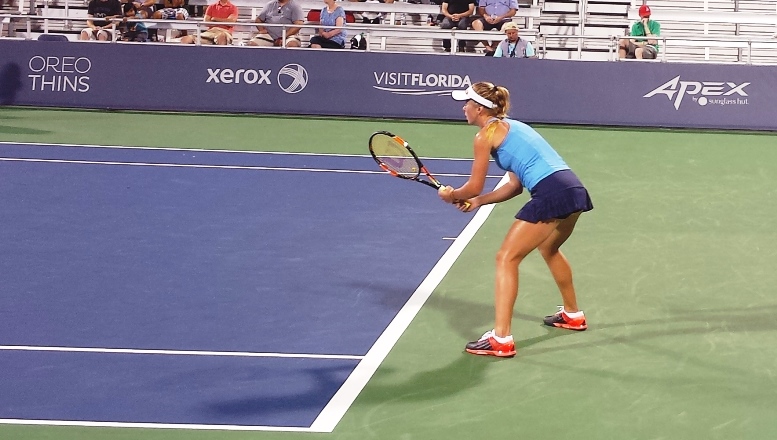
Begu and Cornet were the only ones left playing well past midnight. Tuesday has some explosive matches on the schedule. At 11 AM, there will already be three matches that promise some fireworks. On the Grandstand, two youngsters that are deemed to be an important part of the ATP’s future, Borna Coric and Alexander Zverev (both 18 years old), will battle for a spot in the second round against Stan Wawrinka. On Stadium 3, Nick Kyrgios and Richard Gasquet (remember their epic battles at Wimbledon?) will face each other. On Center Court, the in-form Sloan Stephens will do everything she can to keep the 10th seed Carla Suarez-Navarro out-of-form. Roger Federer vs. Bautista-Agut, Ana Ivanovic vs. Venus Williams, Angelique Kerber vs. Belinda Bencic, Jo-Wilfried Tsonga vs. Fernando Verdasco, Alexandr Dolgopolov vs. Bernard Tomic, Kevin Anderson vs. Leonardo Mayer, and Daria Gavrilova vs. Sara Errani, are some of the other notable matches scheduled for Tuesday. Bring it on!
Note: Watch for commentary posts here and stay tuned to MT-Desk on Twitter for frequent live updates.
Only a retrospective look after June 7th can provide the answer to the question in the title. The clay-court season does nevertheless give valuable indications on what to expect at the 16e arrondissement of Paris once matches begin seven days from now. And then there are the intangibles, always looming on the horizon, ready to influence outcomes. On the men’s side the three-out-of-five-set format will result in awkward scores during long matches (remember for example Marcel Granollers’ upset of the in-form Alexandr Dolgopolov by the score of 1-6 3-6 6-3 6-0 6-2?). It will also and bring into question injuries and physical endurance. On the women’s side, there will be question marks on whether some players who withdrew from clay-court events in the last few weeks can sustain two weeks of high-level competition or not. One intangible for both draws will be whether some past underdogs can manage the responsibility of being favorites in a Major.
The W.T.A. side
If the head-to-head record of Maria Sharapova vs. Serena Williams were not so lopsided, one could pencil the Russian’s name in as the clear favorite. What is quite underrated is how abundantly Sharapova wins matches on clay without playing a clay-court style tennis. Her success on this surface, with a style that favors hard, flat balls, and not much change of pace, would be the main topic of many tactical studies on different surfaces (read that as “for another day”). The good news for Maria is that she earned her way to the number-two ranking during the clay-court season and will not face Serena before the finals under any circumstances. Serena would love to see Sharapova’s name in the finals if she can get there herself, but that remains in doubt due to her less-than-stellar past appearances at Roland Garros, as well as her injury-related glitches during the spring. It seems like the bigger challenge for Serena will consist of going through the earlier rounds without damage, and then maximizing her performance in the later rounds.
Yet, there are potential challengers in the draw. Carla Suarez Navarro, freshly ranked inside the top 10 for the first time in her career, has proven capable of derailing her opponents with a wide arsenal of shots and her nerves of steel. While the spotlight in a Major will be a novelty for the Spaniard, her cool-headed approach to matches, as well as her high on-court IQ level, should be enough to negate the unfamiliar position of being the favorite against the vast majority of her opponents.
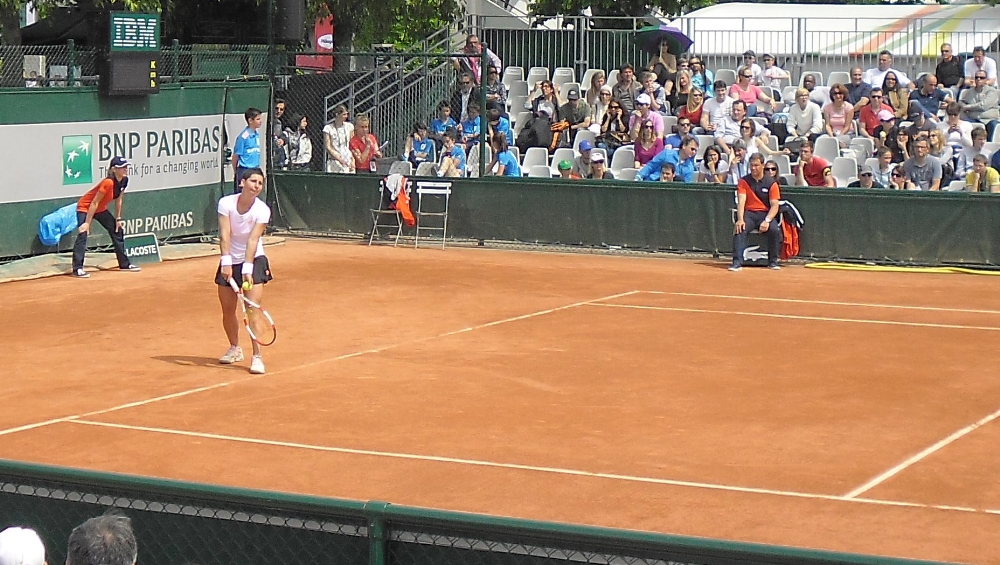 Will Carla still be demoted to the outside courts during Roland Garros after her success this year? (photo – during Roland Garros 2014)
Will Carla still be demoted to the outside courts during Roland Garros after her success this year? (photo – during Roland Garros 2014)
Simona Halep, another favorite despite having garnered no clay-court titles in 2015, will have one clearly defined goal in mind as the number three seed: make it to the semifinal and go through Sharapova or Williams, or both. After reaching the finals last year and raising the bar, Halep is one of the few players, maybe the only one other than Sharapova and Williams, who cannot leave Roland Garros satisfied unless she wins the title.
Outsiders, there are plenty. One that has not gotten any mention in the early reports is Timea Bacsinszky who has been on a tear this year. Yes, she is outside the top 20, and yes, she did get taken out by the sensational Daria Gavrilova in Rome. Past years have shown however that any player who experiences unprecedented success in the clay-court tournaments leading up to Paris can also produce an equal type of run during the two weeks. Finally, there are some familiar names who have gotten the job done at the top level during their career, but are coming into this French Open without much momentum. Svetlana Kuznetsova is a name that no favorite wants to encounter in the first week, especially on her best surface. Although their chances of winning are slim to none, Petra Kvitova can rise up to the occasion on a given day, and players such as Carolina Wozniacki, Ana Ivanovic, Jelena Jankovic, Angelique Kerber, and Sara Errani can extract valuable miles from the legs of those favorites who wish to remain fresh for the “final four” rounds.
The A.T.P. side
2015 has anything but concretized the dominance of the Big Four (yes, capitals are necessary in this case). Or should we distinguish the invincible Novak Djokovic from the other three? If you are one of the many followers of the tennis world who choose to do so, I cannot blame you. The number one player in the world has gone undefeated in four Masters 1000 tournaments (last two on clay) and the Australian Open. He is heading into Roland Garros sporting a 22-match win streak that ironically represents only the third longest one in his spectacular career. He outclassed his two biggest rivals Rafael Nadal and Roger Federer in the two finals on clay, Monte-Carlo and Rome. The improvement in his game – and I can’t underline this enough – since he became number one first in 2011, is something to behold. His serve is now a weapon, his drop shots are uncanny, and in the last few weeks, has even shown remarkable progress in the weakest area of his game, the overhead.
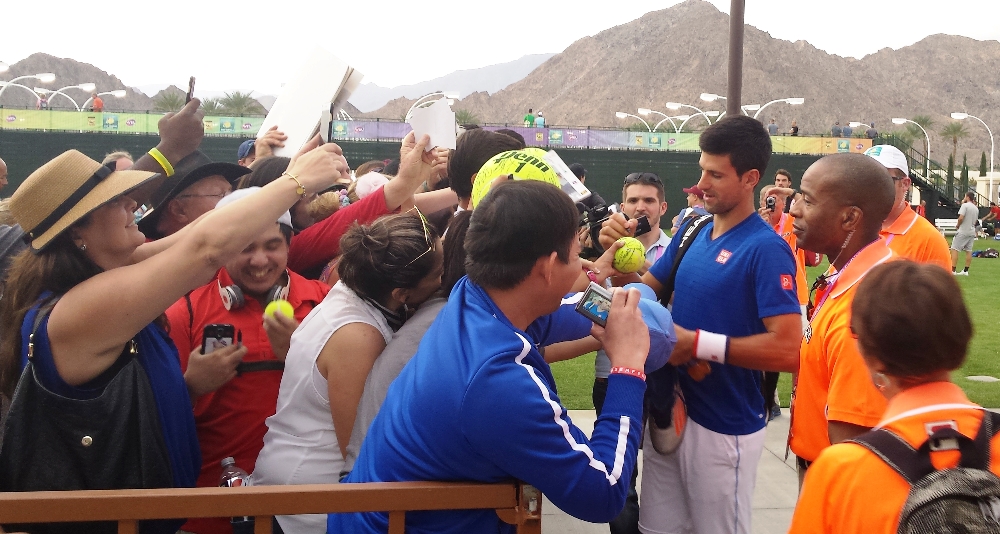 Novak made his fans in Indian Wells happy. Can he do the same for those in Paris?
Novak made his fans in Indian Wells happy. Can he do the same for those in Paris?
Having said that, I am not one of those followers. I cannot separate Novak as a clear favorite from the rest of the field at the French Open, not until a player, as a winner, shakes Rafa’s hand at the net, at the end of an official French Open round match. Nadal has lost before to Djokovic during the clay-court season, only to emerge on the last day at Philippe Chatrier court, as the winner of the only Major of the year on that surface. In fact, this sequence has taken place more than once (2011 and 2014). Last year, Novak entered Roland Garros as the top seed, with a victory against Rafa in Rome, and still came up short. Nadal’s 6-0 record against Djokovic in Roland Garros (three of those in the last three years), and the fact that he lost only one match ever on the red clay of Roland Garros – yes, you read it correctly, ONLY ONE, his record is a stupefying 66-1!! – simply do not allow me to place Djokovic above the Spaniard as the clear favorite. Defeating Nadal by winning three sets against him, in a period of less than a few hours, would still be in the fantasy category for anyone if were not for that one surreal day in 2009, when Robin Soderling banged away warp-speed winners for exactly three hours and a half.
I will thus modify my version to saying that I place Nadal and Djokovic above everyone else, with Federer and Andy Murray slightly below them, followed by a few names that can go no further than possibly spoil the late-round meetings between these four. Roger Federer enters Roland Garros as the second best player of 2015, and even Andy Murray’s late form on clay cannot change that. Roger has earned that seeding, deservedly, by winning three titles, the Istanbul title on clay, and reaching the finals of two Masters 1000 tournaments. The second one of those was today on the clay courts of Foro Italico in Rome, where he was dominated by the lunar play of Djokovic. Murray for his part arrives to Paris with two titles and zero defeats on red dirt (he withdrew from Rome after winning his first match). That is an unprecedented accomplishment for the Scot who, despite often playing well on the surface prior to this year, could never earn a title on it. Yet, Murray and Federer are two of the three reasons – and the only ones in my opinion – that could stop the eventual Nadal vs. Djokovic final. The third is the much-debated seeding question.
Nadal will amazingly be seeded number seven in the very tournament that he won nine times in the last ten years. A combination of rare bad form in the first few months of 2015 and several months of injury-related absence on the ATP Tour in the second half of 2014 has led to Rafa’s lowest ranking ever at the time of Roland Garros. This means that Nadal could face any of the top four seeds as early as in the quarterfinals. The tournament organizers refused to utilize the skewed seeding system that Wimbledon does by taking into consideration the player’s success on the particular surface. Now the ideal situation for them would be that Nadal falls into Berdych’s quarters so that the possibility of semifinals consisting of the Big Four remains alive, and not to mention, likely. It would be a disaster to say the least, if Rafa goes in Novak’s quarters, meaning that by the semifinals, we are guaranteed that one of the two biggest favorites of the tournament, the very two that dominated it for the last three years, will not be present on the last weekend of the event. Rafa could also draw Murray’s quarter of the draw, in which case the next question will beckon: are they on Djokovic’s side or Federer’s side? If they are on Djokovic’s side, Berdych and Federer would rejoice (not publicly of course). If they are on Federer’s side, Federer fans may become the biggest Murray fans for one day if their man makes it to the semis and awaits the winner of Murray-Nadal. These questions will keep the minds of tennis fans, as well as experts, busy until the Main Draw is revealed on May 22nd, at which time all forms of prognostics will inundate social networks and the media.
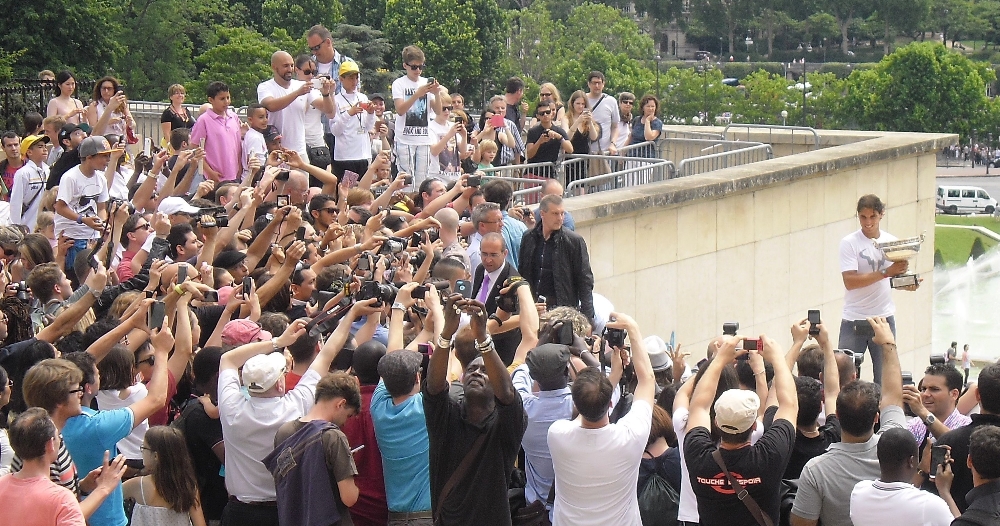 Can Rafa do this again for the 10th time in 11 years, even as the 7th seed in the draw?
Can Rafa do this again for the 10th time in 11 years, even as the 7th seed in the draw?
So, who could play the role of the spoiler to this Big Four party? One of them is Gaël Monfils whom the crowd could galvanize to a higher level of play. He is a name that neither Andy Murray nor Roger Federer would want to see in their quarters, although for Nadal and Djokovic, I doubt it would make much difference. There is also the loose cannon by the name of Fabio Fognini who holds two clay-court wins over Nadal this year, a feat accomplished only by Djokovic until this year. The Italian does not lack the talent to push any player to the limit on a given day, yet his seeding will likely force him to go through several gritty matches to make any major noise, and by now, everyone knows that grit is not Fabio’s forte. It would be fascinating to see him match up with Nadal for the third time on clay, and it could happen as early as the first week, considering their seeding.
Kei Nishikori remains the biggest threat to the Big 4 and the only one who could reach the final weekend without it being considered a stunning upset. Kei will need some help on the day of the draw. As a below-the-top-four seed, it is unlikely that he could go through three big names to lift the trophy on the last Sunday. The two guys on whom everyone has given up any hope of winning Roland Garros are strangely ranked 5 and 8 in the world. The problem with Tomas Berdych and David Ferrer is their miserable record against the Big 4. Yes, each has reached a Major final before (Berdych in Wimbledon 2010 and Ferrer in Roland Garros 2013) but one required a shocking upset (Berdych defeated Federer in 2010) and the other required one of the luckier draws in recent history (2013 French for Ferrer).
Milos Raonic is recovering from surgery and his participation next week is in doubt. Stan Wawrinka could give major headaches to one of the big names, but will not be more than a nuisance to the ensemble of the top favorites. Stan did oust Rafa in Rome, but that remains the one shining moment in his season since he won a title in Rotterdam in February. He is also breaking the cardinal rule for a contender in Majors by participating in a tournament taking place the week preceding a Major, the ATP Geneva event. One guy that did record two wins over Wawrinka in the clay-court season is Grigor Dimitrov. The Bulgarian has however underperformed in light of to the expectations following his successful 2014 campaign. Two Spanish players, Fernando Verdasco and Feliciano Lopez, have proven capable of winning against the best at some points in their careers, and don’t count them totally out. Gilles Simon could also make a big name feel sick in the stomach, but whether that would last more than a couple of sets remains improbable. But in any case, the above-mentioned players, outside of the Big Four, will have to catch fire, of a colossal size, to have any chance of belonging to the “active participant” category in the last few days of Roland Garros.
There are some “far-and-away” outsiders who could find their form and have career tournaments, such as Dominic Thiem, Roberto Bautista Agut, David Goffin, and Richard Gasquet – sorry dear Americans, no John Isner or Jack Sock -, but my use of the adjective “career tournaments” in this case does not point to a shocking upset of one of the Big Four members. With a bit of luck, they could march into the second week of the tournament, and at the most, could reach the quarterfinal rounds.
As for me, I am looking forward, for now, to my favorite portion of the Majors: the qualifying rounds. That is where emotions fly high, away from the scrutiny of cameras for the most part, and where the importance of winning a round often translates into career-high accomplishments, or in the case of a loss, into crushing blows. Enjoy the week, the Parisian party is near.